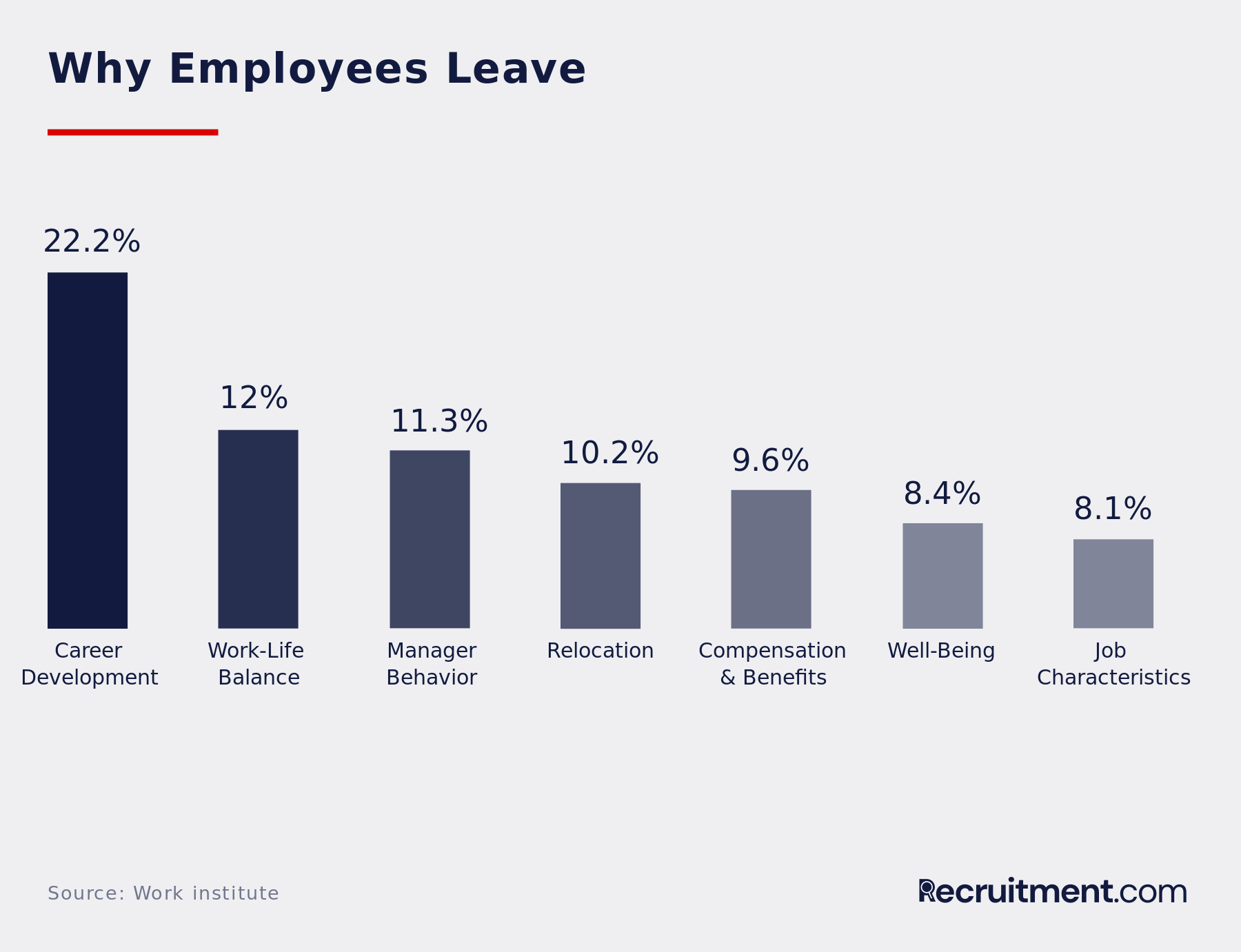The Key To Employee Retention Is Simpler Than You Think

Dann Albright is a writer and researcher specializing in human resources and finance.
Making your organization a place that employees want to stay isn't easy. It takes a concerted effort by executives, managers, and employees to create a culture where everyone feels valued and engaged.What does it take to keep employees at your company? We dug into the research to find out.
Employee turnover hit an all-time high in 2018. And that should worry you. Losing employees is costly in all kinds of ways, from the monetary expense it takes to replace them to the negative effects turnover has on morale.
Which is why many companies are turning their focus to employee retention. Keeping employees on board has a lot of benefits, as we'll see.
Before we discuss that topic, let's talk about why employee retention is such a critical issue
Employee Turnover Is Costly
The Work Institute "conservatively estimates" that replacing an employee costs about $15,000. Combine that with the fact that voluntary turnover is approaching 30% and looks to keep rising, and you start to see why the Institute predicts some serious trouble for employers in the future.
But the cost is even higher than that. When an employee leaves a company, it can hurt morale for the other employees that were close to that person. They might start wondering if they should look for better opportunities, too.
If that employee was in a leadership position, you're left with the difficult task of trying to attract top talent or promoting and training from within. Both options are time-consuming. They can be more expensive, too.
The financial, cultural, and time-related costs of poor employee retention are high, and employers need to take action to reduce turnover. Before you can take action, you need to understand why people are leaving in the first place.
Understanding Why Employees Leave
According to the Work Institute, career development was by far the most common reason that employees sought new opportunities. They want to keep learning, advance their skill sets, and gain more responsibility.
Of course, those activities often come with more pay—but less than 10% of employees mentioned compensation and benefits as the reason they left their jobs. Work-life balance, however, which is also related to compensation, came in at number two.
Interestingly, around 75% of the employees that left a job told the Work Institute they were leaving for preventable reasons. Only about a quarter were relocating, retiring, or being fired.
That should tell you that companies aren't doing enough to keep dedicated, long-term employees on the payroll. But they should be.

Why Employee Retention Is So Important
Replacing employees is expensive. But beyond that, why is hiring a new employee such a big deal?
In an increasingly tight labor market, high-value employees are becoming harder to find. That's starting to worry some companies. When it's hard to recruit top performers, it becomes even more important to keep them.
Veteran employees add a lot of value to your company. They're deeply embedded in the culture. They understand the intricacies of how your company works. They help new hires acclimate to the culture of your company by sharing the unwritten rules and conventions that managers might not even know.
In smaller companies, long-term employees can feel like institutions—when they leave, it's no longer the same company.
That can seriously damage morale and leave you scrambling to find an employee with a similar skillset (which may be impossible, as long-term employees often tailor their skills to their jobs).
All of these facts have bottom-line implications. Which means the cost of employee turnover is much higher than $15,000 per replacement. If employers aren't focused on employee retention, they're doing a disservice not only to their employees, but to their bottom line.
So what can you do about it?

The Key to Retention? Employee Engagement
There's a great deal of crossover between the factors that drive employee turnover and those that affect employee engagement. Quantum Workplace calls employee engagement "the strength of the mental and emotional connection employees feel toward their places of work."
Quantum Workplace also identified six factors that contribute to employee engagement, and they correlate with several of the main reasons that employees leave their jobs:
- The leaders of the organization are committed to making it a great place to work.
- Trust in the leaders of the organization to set the right course.
- Belief that the organization will be successful in the future.
- Understanding of how I fit into the organization's future plans.
- The leaders of the organization value people as their most important resource.
- The organization makes investments to make employees more successful.
Work-life balance (12%), work environment (5.2%), manager behavior (11.3%), and career development (22.2%) are all represented in this list.
What's so important about employee engagement?
In short, engaged employees are much less likely to leave your company. They also perform at a higher level: Gallup's 2017 State of the Global Workforce report shows that companies with high engagement are 17% more productive and 21% more profitable than those with low engagement.
Driving employee engagement, then, is the key not only to retaining top talent, but also to running a successful company.

Putting Engagement First At Your Company
It's one thing to understand that employee engagement is important for retaining your best employees. It's another to actually take steps to improve engagement at your company.
A quick look at the research makes it clear that there's a wide range of factors that influence employee engagement. But the Work Institute's research makes one thing clear: career development is king for retention.
So that's where you should start.
Of course, career development could mean different things to different employees. Being able to earn a promotion and advance to a higher position in the company is an obvious one. But employees also want to improve their skill sets. They want professional training and continual education. They want new experiences and new challenges. They want opportunities to take on more responsibility.
In an age where many employees are being replaced by highly focused freelancers, it's easy to see your company as a group of one-skill workers. But employees are multi-faceted and deserve the chance to not only use, but improve, their skill sets across disciplines.
That means hiring cross-functionally from within. This requires being open to people who wouldn't traditionally be qualified for a job based on their resume—but have the skills and experience that could provide a valuable new perspective on the problems in a particular role.
But you'll need to address the other parts of employee engagement, too. And there are a lot of them, such as:
- Providing workplace education.
- Making sure managers are open and communicative.
- Offering competitive salary and benefits.
- Showing people that their work is meaningful and makes a difference (that's becoming especially important as millennials continue to enter the workforce).
In short, you need to place a very high value on your employees. And not just as sources of single skills—they need to be recognized as people, too.
Understanding Employee Engagement At Your Company
Are your employees engaged? How do you know?
The best way to find out is to simply ask them. Sarah K. White, writing for CIO, suggests three questions:
- Do you feel aligned with your goals?
- Do you have support?
- Are you feeling acknowledged?
The more positive answers you get, the more engaged your employees are.
There are tools designed specifically for this purpose, too. You might use the Utrecht Work Engagement Scale. Or the Gallup Workplace Audit. Gartner has nine questions to gauge employee engagement.
It's a good idea to gather information using tools like these. But don't forget that you already have employee engagement experts in your company: your managers.
Because managers work so closely with employees, they know how employees are feeling, acting, and performing. If they're not seeing engagement, you can bet that your employees aren't engaged.
Employees who leave your company are great sources of information, too. Because they're on their way out, they may be more willing to be open about their criticisms of your company culture.
Exit interviews can be hard, but they can also be fantastic sources of information that you can't get elsewhere.
If managers and employees don't give you a resounding "yes" when you ask about engagement, it's time to take action.
The First Step In Improving Employee Retention
How do you improve employee retention and engagement? Every company will find success with different methods. But Gartner has a list of five things anyone can do right away to improve..
Most notably, Gartner recommends coaching managers on employee engagement and holding them responsible for the engagement of their direct reports.
Managers need to understand that employee engagement is part of their job—and that they're expected to take an active role in building that engagement.
They can build engagement plans with employees--including employee advocacy--track progress, and take action on the individual level. When they understand employees' needs, they can start meeting them.
This not only improves employee engagement but also helps prepare the next generation of leaders at your company. Engaged leaders drive company success and help create a culture that fosters more engaged employees. It's a great cycle to start at your organization.
Conclusion: Retention Starts Early
Too many employers start thinking about retention when a top employee gives his or her two-week notice. They offer a raise and the possibility of a promotion. They ask the employee to stay on just a bit longer. Sometimes they get angry and try to guilt the employee into staying.
But these strategies don't work. What works is creating a company culture that values employees and helps them grow. A culture that fosters engagement and lets employees know that they're valued and have opportunities to grow.
That's what drives employee retention.
- Does your company tend to retain its top employees?
- Do you find it difficult to keep your best performers?
- What have you done to mitigate the temptation to leave for another job?

Dann Albright is a writer and researcher specializing in human resources and finance.






